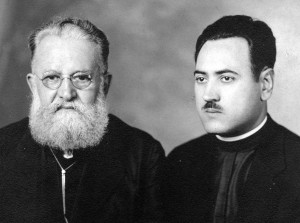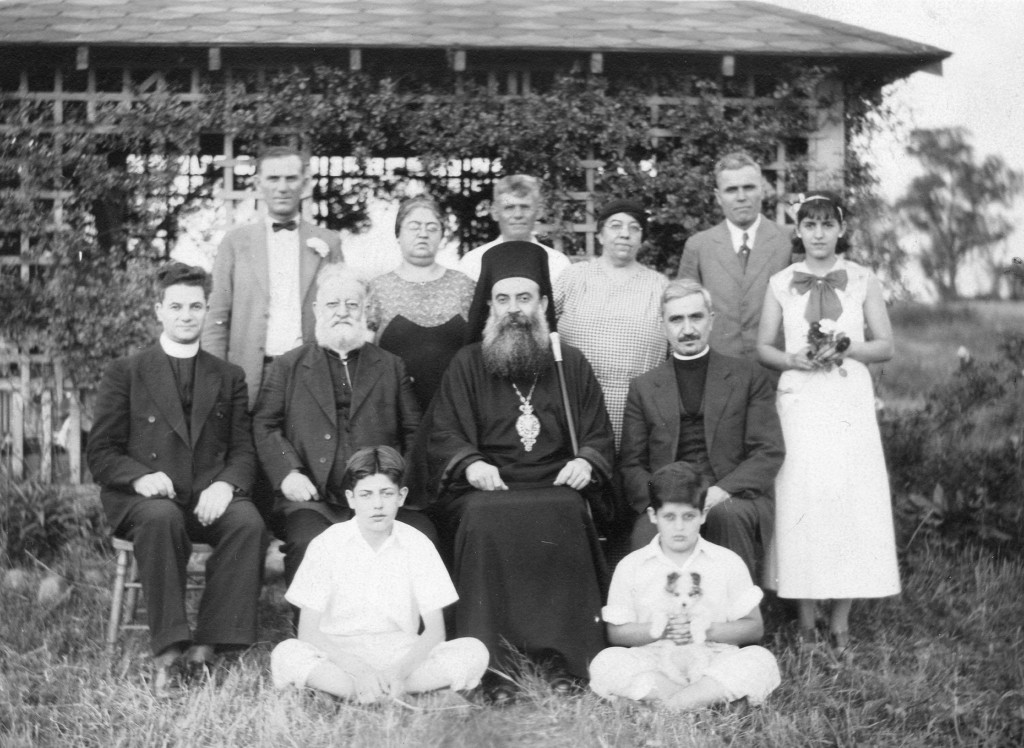Editor’s note: Today we are very pleased to introduce a new author here at OrthodoxHistory.org. Dr. William Samonides of Canton, Ohio, is one of the foremost historians of Greek Orthodoxy in America. With his wife Regine, he coauthored the book Greeks of Stark County (Arcadia Publishing, 2009). I feel pretty confident in saying that Dr. Samonides knows more than anyone about early Greek parish clergy in America.

Father Demetrios Mittacos and Father Gregorios Pantazonis, circa 1936. This is a rare photograph in which the priests of the two rival Greek Orthodox parishes in Canton posed together. The occasion is not known. Father Mittacos served at Holy Trinity in 1936-1937. Father Pantazonis was one of only three priests who served both Canton parishes. He served at Holy Trinity from 1928 to 1931 and at Saint Haralambos from 1931 to 1938.
Holy Trinity Greek Orthodox Church was established in the city of Canton, Ohio, in the early 20th-century boom years of the American steel industry. Orthodox Christians, who flocked to Canton, had already formed three other Orthodox parishes: Romanian, Syrian, and Greek.
Chartered in 1917, Holy Trinity was founded five years before the establishment of the Greek Orthodox Archdiocese of North and South America. It was created as the direct result of a political split in the Canton Greek community. Saint Haralambos, which had been established in 1913, became the parish for supporters of the Greek King Constantine, while backers of Prime Minister Eleftherios Venizelos worshipped at Holy Trinity. This Royalist-Republican split was not unusual; most large Greek communities around the world experienced similar divisions. It is, however, noteworthy that Holy Trinity has maintained its independence long after most of the other parishes that were formed for political reasons have disappeared.
The history of Holy Trinity is quite useful for the study of early Orthodoxy in North America. Stark County was and is home to a concentration of Orthodox Christians from the Pontos region along the Black Sea in the northeastern part of modern Turkey. Holy Trinity is one of few parishes in North America founded primarily by immigrants from Asia Minor. At 10th Street NE, the original site, the first Greek Orthodox church in the region was constructed. In 1927, a Greek community center and hall – also the first in the region – were added.
In recent years Holy Trinity has been at the forefront of Greek Orthodox parishes in the exploration and exhibition of its history. In spring 2004, the parish was the focus in a major exhibition at the Wm. McKinley Presidential Library and Museum in Canton. In 2009, the history of Holy Trinity and two other Greek Orthodox parishes was featured in Greeks of Stark County, a book issued by Arcadia Publishing in the Images of America series. Several months ago, a History Room was created to display changing exhibits exploring different aspects of parish history.
The first History Room exhibit, which is in the process of being mounted, examines the history of the parish through its spiritual leaders. The exhibit focuses on the priests and their accomplishments at Holy Trinity, also discussing their careers before and after serving in Canton. The exhibit also surveys the sacraments – the baptisms, marriages, and funerals – that the priests performed for parish families.
For reconstructing the biographies and understanding the careers of early Orthodox priests in America, parish histories are essential. Unfortunately, all too often the priests who served a parish are reduced to a list of names. Usually the focus is only on the priests’ experiences at the parish. The work of John S. Moraites at Holy Trinity-Saint Nicholas Greek Orthodox Church in Cincinnati, Ohio is a notable exception.
Parish histories can also shed light on larger issues that affected the church and the clergy. One issue that emerges from the study of Holy Trinity history is how much special attention the parish received from the early hierarchs of the Archdiocese. Judging from the visits they made to the parish, it was an important “battleground” in the early years of the Archdiocese. Over 150 parishes were founded before the establishment of the Greek Orthodox Archdiocese in 1922. The first two Archbishops of the Greek Orthodox Archdiocese of America visited Holy Trinity early in their tenure. Archbishop Alexander consecrated Holy Trinity on May 28, 1922, less than three weeks after his appointment as the first Archbishop of the Greek Orthodox Archdiocese of North and South America. This visit to Canton was probably his first extended road trip from New York after becoming Archbishop on May 11.
His successor, Archbishop Athenagoras, made visiting Holy Trinity a priority. In May 1931, he celebrated his first Pentecost as Archbishop at Holy Trinity; this was quite an honor for the parish considering the number of parishes in North America named Holy Trinity.

Photograph of Archbishop Athenagoras and area priests during a visit to Canton in the mid-1930s. Archbishop Athenagoras was a frequent visitor to Stark County during his 18 years as Archbishop of the Greek Orthodox Archdiocese of North and South America.
Archbishop Athenagoras would make many more visits to the area as he worked to reunite the Canton Greek community [see photo]. His efforts were not, however, successful, and the two Canton parishes remained separate. This was not the only area in which Holy Trinity rebuffed the Archbishop. The Holy Trinity Koraes Ladies Society, founded in 1927, resisted joining the Greek Orthodox Ladies Philoptochos Society. Philoptochos, the official philanthropic organization of the Greek Orthodox Church in America, was established by Archibishop Athenagoras in November 1931 and now has more than 475 Philoptochos chapters in the United States. At Holy Trinity, however, the Koraes Ladies Society continues its independence to this day.
Another issue that emerges from the study of early Holy Trinity history is the large number of priests who served the parish before 1940. During the first 22 years, there were 14 priests. This is in contrast to a parish established at about the same time just 20 miles to the north in Akron, Ohio; the Akron parish has been served by only three priests since 1926. Of course, parishes – like priests – all have different “personalities.” The high turnover in priests at Holy Trinity is not a source of pride, but it provides useful information in studying the early priests of the Greek Orthodox Church in North America.
In some respects, Holy Trinity should have been a preferred parish for early Greek Orthodox priests. At the time, most parishes initially rented spaces or purchased buildings from other denominations before raising enough money to construct their own church to Orthodox specifications. Holy Trinity was different. Immediately after receiving its charter, it began to build, and the church was completed before the first priest arrived in October 1917.
Money does not seem to have been an issue. Considering that the parish was mid- sized and most of the parishioners earned low wages in the nearby steel mills, the church was on remarkably firm financial footing. The mortgage was burned less than three years after the state charter was issued. However, none of the parishioners was wealthy, and the parish in later years never paid priests top dollar. During the early 20th century, prior to the establishment of the Greek Orthodox Archdiocese, there were no guidelines for salaries and benefits, and the shortage of priests created a sellers’ market.
Unlike Greek Orthodox parishes, like the Annunciation Cathedral in Atlanta, which has preserved all the minutes from parish council meetings, Holy Trinity has very few early records. Built in a flood plain, the parish was plagued by damaging floods for most of its history, and many of its early records were destroyed. Most of the information on the early history of the parish and priests has been painstakingly compiled from numerous external sources, including local newspaper accounts. This makes it difficult to state with certainty what accounts for the high rate of turnover of priests. Local newspaper reports, however, suggest that the relationship between parish and priests was at times contentious. In January 1921, members of the board of trustees accosted one priest and his wife after Divine Liturgy and were sued for assault. Two years later, another priest sued a parishioner for $10,000, alleging libel. Yet another early priest had a brief stay, because he molested an adolescent girl and was run out of town by her enraged father.
The parish was served by a corps of extremely mobile clergy. They were a well-traveled lot, some serving as far west as Idaho and Utah or as far south as North Carolina and Texas. Most, however, served primarily in the northeastern U.S. Only two are among the “pioneer” priests who founded parishes across North America, and these two served at Holy Trinity toward the end of their careers. All but four of the early priests were ordained before their arrival. Many had been in the U.S. for some time – some more than 30 years – before coming to Canton. Those who did not come to North America as priests had worked in a variety of professions: from sponge diver to confectioner to assembler of automobile parts. Most of the early priests were middle-aged or older; only two of the first priests were under forty. Very few would be buried in the U.S.; even those who had family in America or had become naturalized U.S. citizens chose to retire to Greece.
All but one of the early priests were originally under the jurisdiction of the Ecumenical Patriarch or the Church of Greece. The one exception later became an Archbishop in the Patriarchate of Jerusalem. Little is known of these priests before their arrival in America. Holy Trinity, unlike many other Greek Orthodox parishes established before the Archdiocese, did not summon priests directly from overseas, but hired priests who were available in America. Although most of the parishioners were from Asia Minor, no priest from Asia Minor ever served the parish. Instead, the island of Samos provided more priests for the parish than any other area. There seems to have been an unofficial network of priests from Samos operating in America, which may have been the reason for the high number of Samioti priests at Holy Trinity.
The inaugural exhibit at the Holy Trinity History Room examines these and other issues based on information and photographs collected over the last six years by Holy Trinity Historian, Dr. William H. Samonides. A number of photographs and stories about the early priests of this area can also be found in Greeks of Stark County (Arcadia Publishing, 2009), which he co-authored with his wife Regine.
[This article was written by Dr. William Samonides.]
Sam,
My daughter, Carrie, has been living and working in Thessaloniki for the past 10 months at the American Farm School. She was written up on page 7 of the June 8, 2011 edition of The Hellenic Voice. Thought you’d be interested. Lisa and I went to visit for 10 days in April, had a wonderful time.
Hope all is well. My dad just moved from Sharon, PA but I have to go back there in July to do some stuff with his house. It is about an hour from Canton. Would love to see you if possible, and if you are so inclined. Best, Mark